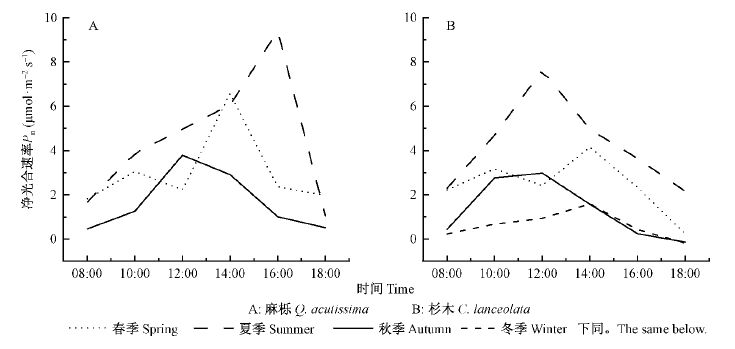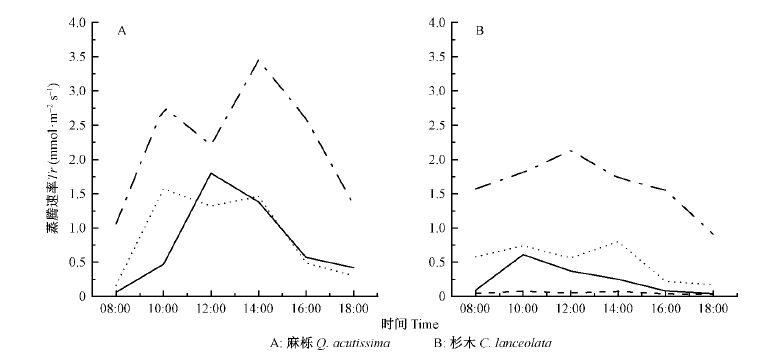文章信息
- 赵文瑞, 刘鑫, 张金池, 王鹰翔, 王金平, 庄家尧
- Zhao Wenrui, Liu Xin, Zhang Jingchi, Wang Yingxiang, Wang Jinping, Zhuang Jiayao
- 南京城郊典型树种光合蒸腾、固碳释氧及降温增湿能力
- Photosynthesis Transpiration, the Carbon Fixation and Oxygen Release, and the Cooling and Humidificant Capacity of Typical Tree Species in Nanjing Suburban
- 林业科学, 2016, 52(9): 31-38
- Scientia Silvae Sinicae, 2016, 52(9): 31-38.
- DOI: 10.11707/j.1001-7488.20160904
-
文章历史
- 收稿日期:2014-12-29
- 修回日期:2016-06-03
-
作者相关文章
造林树种因其大面积种植,光合固碳释氧和降温增湿效应远比城市绿化树种效应大,是人类健康生活必不可少的一部分,因此研究造林树种的固碳释氧和降温增湿效益具有很重要的现实意义(陈月华等,2012; 吴雁雯等,2014; McPherson,1998)。王强等(2015)研究张掖市区12种常见树种的光合蒸腾特性,结果表明梭梭(Haloxylon ammodendron)的光合速率最高且比较节水,为节水高产型,可以作为当地造林的主要树种。靳甜甜等(2008)在对黄土高原常见造林树种光合蒸腾特征研究中发现沙棘(Hippophae rhamnoides)对高原高光强环境适应性较好,为节水高产型。张卫强等(2011)对东江中上游主要造林树种光合生理特征研究中发现木荷(Schima superba)具有高光合、高水分利用效率的生理特性,对环境适应能力强,可以作为当地主要造林树种。目前,对长三角地区典型的优势树种及人工造林树种麻栎(Quercus acutissima)、杉木(Cunninghamia lanceolata)的研究比较少(郭孟霞等,2006; 刘宇,2014; Peng,2004)。本文以南京城郊典型树种麻栎、杉木为研究对象,对其光合蒸腾特性及固碳释氧和降温增湿能力进行研究,为麻栎、杉木林合理经营及其生态环境效益评价提供基础科学数据,以期进一步丰富有关麻栎、杉木物质生产的生理生态学知识,为麻栎、杉木林的合理经营管理以及长江三角洲地区选择生长迅速、节水性能好、社会效益与经济效益双高的造林树种提供理论基础(余新晓等,2005; Georgi et al.,2006)。
1 研究区概况本研究区位于南京市城郊的国营东善桥林场铜山分场(118°50′—118°52′E,31°35′—31°39′N),距南京市约20 km,属北亚热带季风区,年均温15.1 ℃,无霜期229天,年日照2 199天,年平均降水量为1 100 mm,土壤类型为黄棕壤。该地区地形以丘陵为主,海拔在38~388 m,林分类型以杉木、麻栎、马尾松(Pinus massoniana)、毛竹(Phyllostachys edulis)为主。研究区域林分基本特征如表 1。
|
|
对研究区内林木进行调查,选择坡向、坡度、坡位相似的麻栎、杉木林作为研究对象。在麻栎、杉木林内选择标准木作为测定样本。在2013年春、夏、秋、冬4季分别各选择3个典型晴天,每个季节3个典型晴天分别选在1个季节不同月中。使用LI-6400便携式光合作用系统对麻栎、杉木叶片净光合速率、蒸腾速率日进程进行观测,观测时间均由8:00开始,每隔2 h观测1次,18:00时观测结束。每次观测均选取阳面和阴面的生长良好、无病虫害的叶片作为观测叶片,每个时间段观测6片叶子,阳面和阴面各3片,分别放置在上中下同方位,每片叶子3个重复,在同1天采用多台仪器同时测量获取数据,取平均数作为该时段的观测值。测定的指标有蒸腾速率(Tr,mmol·m-2s-1)、净光合速率(Pn,μmol·m-2s-1)、气孔导度(Gs,mol·m-2s-1)、胞间CO2浓度(Ci,μmol·mol-1)、饱和水汽压差(VPD,kPa)、叶片水压亏缺(Vpdl,kPa)。
2.2 环境因子测定使用小气象站进行各环境因子的连续测定,存储30 min的均值,测定的环境因子有太阳辐射(Rs,W·m-2)、空气相对湿度(RHa,%)、空气温度(Ta,℃)、土壤含水率(Swc,v/v)、土壤温度(Ts,℃)。
2.3 叶面积指数的测定使用LAI-2200冠层分析仪测定叶面积指数。在研究区内选择树龄相同、冠型均匀、枝叶茂盛的具有代表性的试验树种各5株,运用LAI-2200冠层分析仪,用60°的镜头在植物的6个不同方向各取一组观测值,仪器自动计算出叶面积指数,每个树种3次重复,取平均值作为最终观测值。
2.4 固碳释氧量的计算
树木单位叶面积日净光合总量计算公式:
树木单位叶面积日蒸腾总量计算公式:
利用Excel2007对数据进行整理分析,线性回归建模等其他统计分析利用spss19.0软件完成,绘图由origin8.6软件完成。
3 结果与分析 3.1 净光合速率(Pn)季节变化由图 1可知,麻栎和杉木在春季净光合速率(Pn)均出现2个峰值,变化表现为双峰曲线,有明显的“光合午休”现象,分别在10:00,14:00达到峰值(3.05μmol·m-2s-1)、(6.57μmol·m-2s-1)和(3.17μmol·m-2s-1)、(4.15μmol·m-2s-1),在12:00左右达到低谷。麻栎、杉木夏季Pn分别在16:00、12:00达到峰值(9.41μmol·m-2s-1)、(7.64μmol·m-2s-1),日变化规律均表现为单峰曲线而不是双峰曲线,并没有表现出明显的“光合午休”现象,且日变化幅度最大。秋季和冬季Pn的日变化均表现为单峰曲线,没有明显的光合“午休”现象,峰值分别出现在12:00和14:00,麻栎为落叶植物,冬天Pn忽略不计。麻栎和杉木在气温高而阳光充足的夏季净光合速率日变化表现为单峰曲线,而没有表现出明显的“光合午休”现象,可能是由于该地区夏季降雨充足,土壤水分在一定程度上缓解了由于植物蒸腾失水而造成的植物体内水分亏缺,因此“午休”现象不明显。双峰曲线出现在春季,可能是由于春季该地区土壤水分不能及时弥补植物蒸腾所需,造成植物水分亏缺,引起气孔的部分关闭,使光合作用受到抑制(李文华,2007)。由表 2可以看出麻栎春、夏、秋3季各季节单位土地面积净光合总量及年净光合总量(102947.083 mmol·m-2)均大于杉木(90152.243 mmol·m-2),说明麻栎总的光合能力比杉木强。

|
图 1 各季节净光合速率日变化 Fig.1 The daily variation of net photosynthetic rate in different season |
|
|
由于不同树种的叶面积指数有差异,所以本文采用计算单位土地面积光合固碳释氧量和蒸腾降温增湿量来评价树木固碳释氧和降温增湿能力,以更加确切地评价和反映树木的生态效益。由2表可知,麻栎、杉木一年四季单位土地面积日固碳量、释氧量变化规律和净光合变化规律一致,表现为夏季>春季>秋季>冬季。夏季固碳释氧能力最强且明显强于其他季节,麻栎夏季单位土地面积日固碳量、释氧量约为春季2倍、秋季3倍左右,杉木夏季约为春季2倍、秋季3倍、冬季7倍左右,冬季固碳释氧能力最低。麻栎春、夏、秋3季各季节单位土地面积日均固碳量、释氧量及其年总固碳量、释氧量均大于杉木,说明麻栎总的固碳释氧能力比杉木强。
3.3 蒸腾速率(Tr)季节变化由图 2可知,麻栎夏季、春季蒸腾速率(Tr)的日变化表现为双峰曲线,春季均分别在10:00(1.57 mmol·m-2s-1)、14:00(1.46 mmol·m-2s-1)达到峰值,夏季峰值依次分别为2.77,3.45 mmol·m-2s-1, 中午12:00左右达到低谷。秋季Tr变化表现为单峰曲线,在12:00左右达到峰值(1.80 mmol·m-2s-1)。杉木春、冬季Tr日变化规律表现一致,均出现2个峰值,表现为双峰曲线,春季分别在10:00(0.74 mmol·m-2s-1),14:00(0.80 mmol·m-2s-1)达到峰值,冬季在10:00(0.075 mmol·m-2s-1),14:00(0.071 mmol·m-2s-1)达到峰值,均在12:00左右出现低谷。夏、秋季表现为单峰曲线,夏季在12:00达到最高值(2.13 mmol·m-2s-1),秋季在10:00达到最高值(0.612 mmol·m-2s-1)。相同条件下,麻栎春季日蒸腾曲线表现为双峰曲线,而杉木表现为单峰曲线,这可能是由于麻栎耗水量较大,造成植物水分亏缺,引起气孔的部分关闭,蒸腾速率随之下降,故表现为双峰曲线(佟潇,2010)。由表 3可知:麻栎春、夏、秋3季各季节白天单位土地面积日均蒸腾总量及其年总量(44 469.713 mol·m-2)远大于杉木(24 433.623 mol·m-2),说明麻栎蒸腾能力比杉木强,比较耗水。

|
图 2 各季节蒸腾速率日变化 Fig.2 The daily variation of transpiration rate in different seasons |
|
|
由表 3可知:麻栎、杉木单位土地面积日增湿量、降温量同蒸腾速率变化一致,表现为:夏季>春季>秋季>冬季。夏季增湿降温效果最明显,麻栎夏季单位土地面积降温量约是春、秋季的3倍,杉木夏季约为春季的3倍、秋季的6倍。单位土地面积日增湿量表现为麻栎夏季约为春秋季的3倍,杉木夏季约为春季3倍、秋季的6倍,冬季增湿降温效果为1年中最低。
麻栎春、夏、秋3季各季节单位土地面积白天日均增湿量、降温量及其年增湿总量、降温总量均大于杉木,麻栎单位土地面积年蒸腾增湿量和降温量约为杉木2倍,说明麻栎增湿降温能力比杉木强。和汪成忠(2009)在上海8种园林树木生态功能比较研究中的主要园林绿化树种[奕树(Koelreuteria paniculata)、杜英(Elaeocarpus sylvestris)、女贞(Ligustrum lucidum)、桂花(Osmanthus fragrans)、紫叶李(Prunus cerasifera)、蚊母树(Distylium racemosum)、碧桃(Amygdalus persica)、石楠(Photinia serrulata)]相比,麻栎降温增湿量除比紫叶李低外,比其他7个树种高,说明麻栎降温增湿能力与园林绿化树种相比还是相对比较高。
3.5 多元回归模型分析分别以Pn,Tr为因变量,以气孔导度(Gs)、胞间二氧化碳浓度(Ci)、叶表面蒸汽压亏缺(Vpdl)、太阳辐射(Rs)、空气温度(Ta)、饱和水汽压差(VPD)、土壤含水率(SwC)、土壤温度(Ts)为自变量,采用逐步剔除法进行多元回归分析,建立麻栎、杉木各季节叶片Pn,Tr与生理生态因子之间的回归模型,进入各模型的因子即为各季节影响麻栎、杉木叶片光合、蒸腾的主要因子。
由表 4,5可知,各模型的决定系数普遍较高,介于0.702~0.998,其中0.9以上占据绝大部分,除了杉木春季净光合速率、蒸腾速率的模型为显著水平,其余各模型均达到极显著水平,各季节麻栎、杉木叶片的光合、蒸腾速率与各影响因子之间的拟合度很高、拟合效果很好。可以通过该模型对长三角区麻栎、杉木各季节光合、蒸腾速率进行模拟预测,拟合出各季节的光合、蒸腾速率变化规律,为早期预测光合潜能提供理论依据。
|
|
|
|
对于蒸腾速率,麻栎春秋季、杉木夏秋的模型中均只含有气孔导度,说明这几个季节气孔导度在影响叶片蒸腾速率中起到主要作用;麻栎夏季模型中气孔导度、叶表面蒸汽压亏缺进入模型,说明麻栎夏季气孔导度、叶表面蒸汽压亏缺是影响叶片蒸腾速率的主要因素;杉木春季只有土壤含水率进入模型,说明杉木春季叶片蒸腾速率农桑土壤含水率影响比较大。杉木秋季、冬季主要影响因素分别为气孔导度和饱和水汽压差、气孔导度和土壤含水率。
4 讨论1) 本研究得出麻栎、杉木单位土地面积光合固碳释氧和蒸腾降温增湿能力同净光合速率、蒸腾速率总体变化规律一致,表现为:夏季>春季>秋季>冬季,夏季最高且明显高于其他季节,冬季最低且明显低于其他季节。这与史晓丽(2010)在研究北京地区行道树固碳释氧规律和汪成忠(2009)研究上海园林树木降温增湿规律一致。而陆贵巧等(2009)研究大连市主要行道绿化树种在不同季节固碳释氧量的总体变化规律表现为夏季>秋季>春季;张艳丽等(2013)研究成都市沙河主要绿化树种认为树种在不同季节降温增湿量的总体变化规律表现为夏季>秋季>春季。以上2项研究结果与本研究不一致,这可能与所处的地理位置、生态环境及树种有一定的关系。麻栎单位土地面积日均固碳量、释氧量、增湿量、降温对应年总量均大于杉木,这与于雅鑫等(2013)在研究木兰科(Magnoliaceae)乔木得出的落叶乔木的光合固碳释氧和蒸腾降温增湿能力比常绿乔木强的结论一致,同时也说明树种是影响固碳释氧和降温增湿能力高低的一个非常重要的因素,这可能与叶面积指数和树木内部结构特征差异有关(Zhou,2004)。通过对麻栎、杉木不同季节光合蒸腾特性及多元回归模型研究分析可知,林木光合、蒸腾规律随季节气候、树种在不断变化,同一树种不同季节、不同树种同一季节光合、蒸腾规律及各生理生态因子对光合蒸腾的影响也表现出显著差异。
2) 树木在不同季节光合固碳释氧能力和蒸腾降温增湿能力均存在显著差异。夏季由于温度高、太阳辐射高、水分充足、树木各项生理生态活性高,光合、蒸腾能力均达最高,日变幅度最大(齐化龙等,2008; Samuelson et al.,2006)。春季树木各项生理活性较高,因此春季光合、蒸腾能力比较高(黄志宏等,2009; 宋清海等,2013)。秋天到冬天外界环境逐渐变化,树木各项生理生态活性逐渐降低,故其光合、蒸腾能力也逐渐降低。冬季寒冷、太阳辐射减弱、降水减少、林木各项生理生态活性明显下降,光合、蒸腾能力均达最低,日变幅度最小,此现象也与叶片衰老有关,秋天到冬天叶片叶绿素含量减少是引起光合速率减小的原因之一(夏磊,2011; 徐佳佳等,2011)。故春季和秋季其光合、蒸腾能力介于夏季和冬季之间。本文只是通过叶片光合气体交换测定值来估算树木单位固碳释氧和降温增湿能力,并未考虑枯落物分解等其他影响因子的影响,更加精确的估算还有待进一步地研究。
| [1] |
陈月华, 廖建华, 覃事妮. 2012. 长沙地区19种园林植物光合特性及固碳释氧测定. 中南林业科技大学学报 , 32 (10) : 116–120.
( Chen Y H, Liao J H, Tan S N.2012. Studies on photosynthetic characteristics and carbon fixation and oxygen release capabilities of 19 garden plants in Changsha area. Journal of Central South University of Forestry & Technology , 32 (10) : 116–120. [in Chinese] ) (  0) 0)
|
| [2] |
郭孟霞, 毕华兴, 刘鑫. 2006. 树木蒸腾耗水研究进展. 中国水土保持科学 , 4 (4) : 114–120.
( Guo M X, Bi H X, Liu X.2006. Review on the water consumption of tree transpiration. Science of Soil and Water Conservation , 4 (4) : 114–120. [in Chinese] ) (  0) 0)
|
| [3] |
黄志宏, 周光益, 邱治军. 2009. 南岭森林3种常见树种光合-蒸腾作用特性. 中南林业科技大学学报 , 29 (2) : 18–24.
( Hang Z H, Zhou G Y, Qiu Z J.2009. Photosynthesis and transpiration characteristics of three typical tree species in the forests of Nanling mountains northern Guangdong. Journal of Central South University of Forestry & Technology , 29 (2) : 18–24. [in Chinese] ) (  0) 0)
|
| [4] |
靳甜甜, 刘国华, 胡婵娟, 等. 2008. 黄土高原常见造林树种光合蒸腾特征. 生态学报 , 28 (11) : 5758–5765.
( Jin Q Q, Liu G H, Hu C J, et al.2008. Characteristics of photosynthetic and transpiration of three common afforestation species in the loess plateau. Acta Ecologica Sinica , 28 (11) : 5758–5765. [in Chinese] ) (  0) 0)
|
| [5] |
李文华.2007.陕北黄土区主要造林树种蒸腾耗水及光合特性研究.北京:北京林业大学硕士学位论文. ( Li W H.2007.Studies on photosynthetic physiology and water consumption characteristics of main tree species in loess plateau of northern Shaanxi.Beijing:MS thesis of Beijing Forestry University.[in Chinese][in Chinese]) |
| [6] | 刘宇. 2014. tudy on transpiration characteristics of two typical forests in loess hillv region of west Shanxi. Beijing: Beijing Forestry University Press . |
| [7] |
陆贵巧, 尹兆芳, 谷建才, 等. 2009. 大连市主要行道绿化树种固碳释氧功能研究. 河北农业大学学报 , 29 (6) : 49–51.
( Lu G Q, Yin Z F, Gu J C, et al.2009. A research on the function of fixing carbon and releasing oxygen of afforestation trees along the main road in Dalian city. Journal of Agricultural University of Hebei , 29 (6) : 49–51. [in Chinese] ) (  0) 0)
|
| [8] |
齐化龙, 张维江. 2008. 毛乌素沙地沙生植物蒸腾规律探讨. 农业科学研究 , 29 (1) : 61–65.
( Qi H L, Zang W J.2008. A study of plant transpiration rules in Mu Us Desert. Journal of Agricultural Sciences , 29 (1) : 61–65. [in Chinese] ) (  0) 0)
|
| [9] |
史晓丽.2010.北京市行道树固碳释氧滞尘效益的初步研究.北京:北京林业大学硕士学位论文. ( Shi X L.2010.Preliminary study on fixing carbon dioxide releasing oxygen and retention of dust of street strees in Beijing.Beijing:MS thesis of Beijing Forestry University.[in Chinese][in Chinese]) |
| [10] |
宋清海, 张一平, 谭正洪, 等. 2013. 热带雨林冠层树种绒毛番龙眼树冠蒸腾及其与气候因子的关系. 东北林业大学学报 , 41 (3) : 6–8.
( Song Q H, Zang Y P, Tang Z H, et al.2013. Canopy transpiration and its relationship with meteorological factors of Pometia tomentosa in tropical rain. Journal of Northeast Forestry University , 41 (3) : 6–8. [in Chinese] ) (  0) 0)
|
| [11] |
苏东凯, 周永斌, 唐庆华, 等. 2006. 不同杨树品种光合生理生态特性的研究. 西北林学院学报 , 21 (2) : 39–41.
( Su D K, Zhou Y B, Tang Q H, et al.2006. Ecophy siological characteristis of photosynthesis in different Popular trees. Journal of Northwest Forestry University , 21 (2) : 39–41. [in Chinese] ) (  0) 0)
|
| [12] |
佟潇, 李雪. 2010. 沈阳市5种绿化树种固碳释氧与降温增湿效应研究. 辽宁林业科技 , 5 (3) : 14–16.
( Tong X, Li X.2010. Effects of release of oxygen and carbon sequestration and temperature lowering and humidity increasing by 5 afforestation tree species in Shenyang City. Liaoning Forestry Science and Technology , 5 (3) : 14–16. [in Chinese] ) (  0) 0)
|
| [13] |
吴雁雯, 张金池, 顾哲衍, 等. 2014. 百山祖两种阔叶木本植物的光合蒸腾作用特性研究. 水土保持研究 , 21 (6) : 204–210.
( Wu Y W, Zhang J C, Gu Z Y, et al.2014. Study on photosyn thesis-transpiration characteristics of two broadleaf woody plant species in the forests of Baishanzu. Research of Soil and Water Conservation , 21 (6) : 204–210. [in Chinese] ) (  0) 0)
|
| [14] |
汪成忠.2009.上海八种园林树木生态功能比较研究.哈尔滨:东北林业大学硕士学位论文. ( Wang C Z.2009.A comparative study on the ecological function of eight kinds of ornamental woody plants in Shanghai.Harbin:MS thesis of The Northeast Forestry University.[in Chinese][in Chinese]) |
| [15] |
王强, 蒋志荣, 张云亮. 2015. 张掖市主要造林植物光合特性研究. 甘肃农业大学学报 , 50 (2) : 122–126.
( Wang Q, Jiang Z R, Zhang Y L.2015. Research on photosynthesis physiological characteristics of main afforestation tree species in Zhangye city. Journal of Gansu Agricultural University , 50 (2) : 122–126. [in Chinese] ) (  0) 0)
|
| [16] |
夏磊. 2011. 重庆市常见园林植物光合生理生态特性与生态效应研究. 重庆: 西南大学出版社 .
( Xia L. 2011. Study on ecophotosynthetic characteristics and ecological effects of common landscape plants in Chongqing. Chongqing: Southwest University Press . [in Chinese] ) |
| [17] |
徐佳佳, 张建军, 王清玉, 等. 2011. 油松和侧柏的光合蒸腾特性及其与环境因子的关系. 东北林业大学学报 , 39 (7) : 15–18.
( Xu J J, Zhang J J, Wang Q Y, et al.2011. Photosynthesis and transpiration characteristics of Piuus tabulaeformis and Platycladus orieutalis and their relationship with environmental factors. Journal of Northeast Forestry University , 39 (7) : 15–18. [in Chinese] ) (  0) 0)
|
| [17] |
杨钙仁, 苏晓琳, 蔡德所, 等. 2013. 针阔混交林转为桉树林对森林小气候的影响. 水土保持研究 , 20 (5) : 129–134.
( Yang G R, Su X L, Cai D S, et al.2013. Impact of vegetation shift from coniferous and broadleaf mixed forest to Eucalyptus plantation on the microclimate. Research of Soil and Water Conservation , 20 (5) : 129–134. [in Chinese] ) (  0) 0)
|
| [19] |
余新晓, 鲁绍伟, 靳芳, 等. 2005. 中国森林生态系统服务功能价值评估. 生态学报 , 25 (8) : 2096–2102.
( Yu X X, Lu S W, Le F, et al.2005. The assessment of the forest ecosystem services evaluation in China. Acta Ecologica Sinica , 25 (8) : 2096–2102. [in Chinese] ) (  0) 0)
|
| [20] |
杨士弘. 1994. 城市绿化树木的降温增湿效应研究. 地理研究 , 13 (4) : 74–80.
( Yang S H.1994. Urban greening trees cooling humidification effect research. Geographical Research , 13 (4) : 74–80. [in Chinese] ) (  0) 0)
|
| [21] |
于雅鑫, 胡希军, 金晓玲. 2013. 12种木兰科乔木固碳释氧和降温增湿能力研究. 广东农业科学 , 13 (6) : 47–50.
( Yu Y X, Hu X J, Jin X L.2013. Carbon fixation and oxygen release,cooling and humidification of 12 Magnoliaceae species. Guangdong Agricultural Science , 13 (6) : 47–50. [in Chinese] ) (  0) 0)
|
| [22] |
张卫强, 曾令海, 王明怀, 等. 2011. 东江中上游主要造林树种光合生理特征. 生态环境学报 , 20 (1) : 51–57.
( Zhang W Q, Zeng L H, Wang M H, et al.2011. The photosynthetic physiological characteristics of main tree species in the upper and middle reaches of Dongjiang watershed. Ecology and Environmental Sciences , 20 (1) : 51–57. [in Chinese] ) (  0) 0)
|
| [23] |
张艳丽, 费世民, 李智勇, 等. 2009. 成都市沙河主要绿化树种固碳释氧和降温增湿效益. 生态学报 , 33 (12) : 3878–3889.
( Zang Y L, Fei S M, Li Z Y, et al.2009. Carbon sequestration and oxygen release as well as cooling and humidification efficiency of the main greening tree species of Sha River,Chengdu. ooling and humidification efficiency of the main greening tree species of Sha River, , 33 (12) : 3878–3889. [in Chinese] ) (  0) 0)
|
| [24] |
Georgi N J, Zafiriadis K.2006. The impact of park trees on microclimate in urban areas. Urban Ecosyst , 9 (3) : 195–209.
DOI:10.1007/s11252-006-8590-9 ( 0) 0)
|
| [25] |
McPherson E G.1998. Atmospheric carbon dioxide reduction by Sacramento's urban forest. Journal of Arboriculture , 24 (4) : 215–223.
( 0) 0)
|
| [26] |
Peng Z H.2004. Networking forests and water areas:urban forest development in China. Chinese Forestry Science and Technology , 3 (3) : 7–18.
( 0) 0)
|
| [27] |
Samuelson L J, Stokes T A.2006. Transpiration and canopy stomatal conductance of 5-year-old loblolly pine in response to intensive management. Forest Science , 52 (3) : 313–323.
( 0) 0)
|
| [28] |
Zhou Z H.2004. Application of native tree species to urban Forest. Chinese Forestry Science and Technology , 11 (3) : 73–77.
( 0) 0)
|
 2016, Vol. 52
2016, Vol. 52

